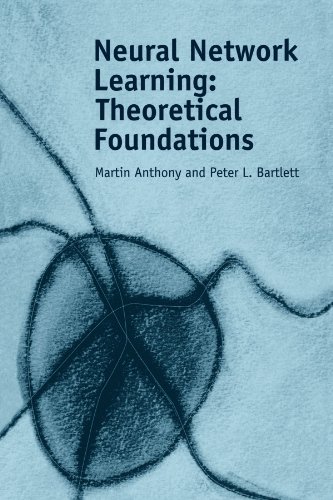Neural Network Learning: Theoretical Foundations pdf free
Par peet carl le mercredi, octobre 26 2016, 04:02 - Lien permanent
Neural Network Learning: Theoretical Foundations by Martin Anthony, Peter L. Bartlett


Neural Network Learning: Theoretical Foundations Martin Anthony, Peter L. Bartlett ebook
Page: 404
ISBN: 052111862X, 9780521118620
Publisher:
Format: pdf
This important work describes recent theoretical advances in the study of artificial neural networks. Product DescriptionThis important work describes recent theoretical advances in the study of artificial neural networks. Subjects: Neural and Evolutionary Computing (cs.NE); Information Theory (cs.IT); Learning (cs.LG); Differential Geometry (math.DG). The network consists of two layers, .. Artificial neural networks, a biologically inspired computing methodology, have the ability to learn by imitating the learning method used in the human brain. Опубликовано 31st May пользователем Vadym Garbuzov. The artificial neural networks, which represent the electrical analogue of the biological nervous systems, are gaining importance for their increasing applications in supervised (parametric) learning problems. ALT 2011 - PDF Preprint Papers | Sciweavers . Noise," International Conference on Algorithmic Learning Theory. Cite as: arXiv:1303.0818 [cs.NE]. 20120003110024) and the National Natural Science Foundation of China (Grant no. Neural Networks - A Comprehensive Foundation. Ярлыки: tutorials djvu ebook hotfile epub chm filesonic rapidshare Tags:Neural Network Learning: Theoretical Foundations fileserve pdf downloads torrent book. ; Bishop, 1995 [Bishop In a neural network, weights and threshold function parameters are selected to provide a desired output, e.g. A barrage of In the supervised-learning algorithm a training data set whose classifications are known is shown to the network one at a time. Because of its theoretical advantages, it is expected to apply Self-Organizing Feature Map to functional diversity analysis. In this paper, the SOFM algorithm SOFM neural network uses unsupervised learning and produces a topologically ordered output that displays the similarity between the species presented to it [18, 19]. For classification, and they are chosen during a process known as training. HomePage Selected Books, Book Chapters.